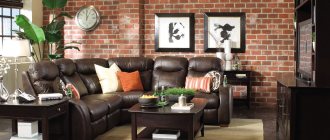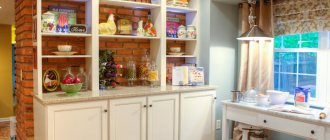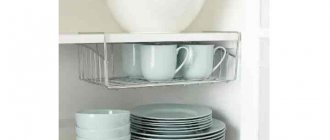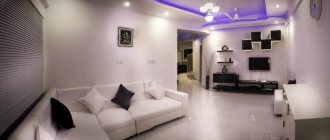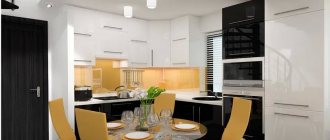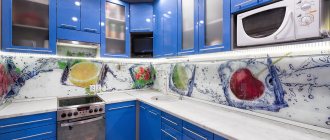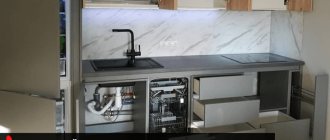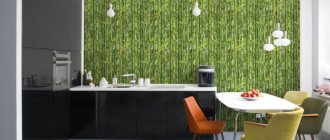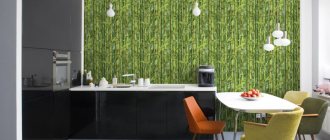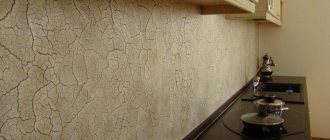The popular finishing material has a recognizable look and harmoniously combines with different styles. The raw material is not universal, so it is not suitable for all design areas.
Unusual design move Source ciscoexpo.ru
Kitchen with seating area Source happymodern.ru/
Who would benefit from a brick wall in the kitchen?
For lovers of non-standard and bold interior solutions. Although brickwork is already a well-established technique, it is not suitable for everyone. If you are a follower of the classics, it is hardly worth going to such experiments.
- Those who want to create an accent in the room. The kitchen is the place in the house where everything has a utilitarian meaning. As a rule, standard apartments cannot boast of spacious cooking areas. If you want to somehow accentuate the space, a brick wall is a good option!
- Economical. With brick or material for it, you can decorate a fairly large area with a relatively small financial investment.
Experimenters and self-taught people. You'll almost certainly want to create a brick wall yourself once you discover how easy but exciting the process is!
Dimensions
To decorate residential interiors today, you can choose panels of different sizes that imitate the aesthetics of brick. With larger options the work proceeds faster. In addition, when using such products, you can get fewer joints, because they allow you to cover a large base area in one. As a result, the interior design is more concise and attractive.
For spacious rooms, large slabs of any color will be more appropriate; for narrow rooms, small slabs in lighter colors will be more appropriate. This will allow you to achieve visual correction of the space.
Note that, if necessary, slabs of this nature for decorating living rooms from the inside can be cut into smaller pieces with a stationery knife. For example, when designing columns, decorative fireplaces, niches, and so on.
Which interior will it fit into?
Brickwork in the kitchen is a sign of many interior styles.
- Loft. Traditional solution within this direction. The roughness of the texture of the material can be emphasized by other brutal details or, conversely, softened due to them.
- Scandi. If you are a follower of the Scandinavian style, it is better to give preference to a light shade of the material or paint it. Pure white, light gray, light beige and other soft shades would be appropriate.
- Provence. The style of the French suburbs harmonizes perfectly with light brick or its imitations. The color scheme will avoid light absorption.
- Gothic. Another style, in addition to loft, where it is worth preserving the roughness of the texture or artificially imparting it. Gothic allows you to leave the brick as natural as possible.
- Pop Art. Explosions of bright colors and flashy details typical of pop art will look great against the backdrop of light or low-contrast colored masonry.
- Mediterranean. The name of the style speaks for itself: shades of water and sand, bleached wood, a lot of air and light in the room. If you want to fit a brick into it, remember the color scheme and do not place it over a large area.
Pros and cons of a brick wall
In addition to its spectacular appearance, a brick wall has other advantages:
- High wear resistance;
- Wet resistance;
- Resistance to high temperatures;
- Ease of execution;
- Natural and environmentally friendly.
But there are also disadvantages:
- Difficulty in cleaning (due to the roughness of the material it is difficult to wash);
- Light absorption (matte surfaces do not reflect light, which visually “eats” and makes the space heavier).
Tip 3. Decide on the texture
The brick does not have to be porous, like the one we are used to seeing in exterior decoration. Now the blocks are treated with a special glaze, which allows you to give the most varied appearance to the material.
Bricks can be very different
For example, you can use classic matte bricks - they are great for creating traditional interiors.
The usual matte brick
However, glossy glazed bricks also look very interesting. In addition, due to their reflective properties, they visually make a small kitchen larger. A significant bonus, especially when you consider that the brick itself conceals the space, making it smaller and cramped.
Interesting and attractive solution
A fashionable solution for interiors in the industrial loft style is chipped brick. The blocks appear a little broken, their edges are torn, and their texture is uneven. Due to this, the coating seems very voluminous and original. True, you need to work with such material very carefully, otherwise the kitchen will take on a sloppy, abandoned appearance.
Rough finishes should be compensated with elegant furniture
Material selection
You can make a brick wall in the kitchen in a variety of ways. Let's go from simple to complex.
Natural brick
Are you the proud owner of a truly brick wall in your kitchen, but aren't sure whether to leave it that way or plaster it? Not many people are so lucky! Dare to try this experiment, because it will not require much financial or time investment from you.
It is enough to clean the wall, putty the uneven areas - and then you can simply coat the brick with varnish to protect it or paint it with a suitable color.
Tip 7. Organize your lighting correctly
Brick does not have very good reflective properties. Therefore, we recommend placing a brick wall opposite the window - so natural light will smooth out this effect.
A kitchen with brick requires a lot of light
In addition, it is very important to properly highlight a prominent wall. Use several lamps at once - this will help highlight the beauty of the brick.
Lamps must fit into the interior and complement it
Additional lighting won't hurt
Wallpaper
If you doubt whether this interior solution will suit you, you can “rehearse” it by gluing wallpaper with a brick pattern.
Now manufacturers offer a huge selection of such wallpapers:
- From a simple schematic image to a three-dimensional and textured one, when from a distance you won’t understand that this is wallpaper in front of you.
- Perfect as a decorative option in the eating area or where storage is organized.
- The main thing is to avoid contact with water and fire!
Tile
There is a huge selection of tiles that imitate masonry. These can be luxurious cuts of natural vintage brick, or budget gypsum tiles. It will turn out quite natural and relief. This option is suitable for both decoration and practical purposes, because the materials are washable, heat- and wear-resistant.
Gypsum plaster
An excellent and very budget solution is to create a brick wall with your own hands using gypsum plaster. A master can help you with this, but if you decide to do it yourself, you will get a lot of positive emotions and valuable experience. We'll tell you further how to make a wall from such plaster with your own hands!
Finally, if you like the graphic effect that brick creates on a wall, but don't want to use any of the materials listed, tile may be your option.
A very common model now is the “white boar” - an elongated tile in the shape of a rectangle. It will appeal to those who want to decorate an apron.
Tip 5. Take care of additional processing
If you want to place a brick directly next to the oven or use it to decorate an apron, we recommend that you additionally cover it with a thin layer of scraping varnish. This will greatly simplify cleaning - dirt and grease will not penetrate the pores of the material, which means the coating will last you longer.
If you want to use brick near the work surface, it is better to further process it
If you are afraid that such processing will spoil the texture of the brick, do not worry. Modern materials can be applied in one layer, so that they form a thin protective film, not too noticeable at first glance.
Modern means make processing invisible
In addition, no one forces you to choose a flashy glossy finish - you can easily use matte varnish.
How to make a brick wall in the kitchen yourself
You will need:
- Gypsum plaster - the consumption is quite large; at least half a bag is needed for the wall in the dining area;
- Adhesive primer;
- Thin masking tape;
- Putty knife;
- Trowel;
- Several markers;
- Coating paint.
Step-by-step instruction
- Prime the wall and dry it completely.
- You measure the wall and calculate what size the “bricks” will be and how many rows you will have.
- Make the markings using a marker, drawing out the layout (if possible, use a laser level, this will save several hours).
- Glue the masking tape according to the markings: extend the horizontal lines beyond the edge of the wall, leaving a free end of the tape, the vertical lines are short, they must overlap the horizontal ones.
- Mix the solution: add water to the plaster until it has a homogeneous, not too thick and non-liquid consistency, you can add a little PVA glue, it acts as a plasticizer, preventing the mixture from hardening too quickly.
- Using a spatula, apply the mixture to several adjacent “masonry”, starting from the top of the wall. Dry for 15 - 20 minutes.
- When the solution “takes hold” and begins to harden, carefully pull the remaining horizontal ends of the tape, they will drag the vertical lines along with them, and a three-dimensional pattern of brickwork will remain on the wall.
- Before it hardens completely, smooth out the unevenness with a trowel or, conversely, add texture with a spatula or gloved hands.
- You can take on the next rows.
- It will take several days for the composition to dry. Then cover the “masonry” with paint of a suitable color.
If you are a master with no experience, all this work will take you several days. But the effect will definitely please you! In addition, this idea is really very budget-friendly.
Installation features
As a rule, boards made of plastic material are glued directly to the wall surface, without paying attention to small irregularities. The material is elastic, and it is allowed to work with it with small deviations. If uneven areas exceed the permissible values, the slabs are installed on a slatted frame or plywood sheets.
The algorithm of actions is as follows:
- horizontal slats are placed on the wall;
- plastic panels are fixed to the frame base;
- First, the rail is filled from above, after which, under the control of a plumb line, a similar guide is fixed from below. It remains to fasten the middle strips at a certain interval, and the frame base is ready;
- The starting guide is fixed with a stapler, after which the plates are installed sequentially;
- Before adjusting and installing the last panel, a finishing guide is tamped on top.
For ease of use you will need:
- construction plumb and cord;
- frame slats made of wood or metal;
- perforator;
- profile guides “start” and “finish”;
- stapler and steel staples;
- dowels, screws.
Zoning options
Blending brick harmoniously into your interior is not such an easy task. If you plan and implement this idea yourself, be very careful!
Of course, brickwork won't stay with you for life. And, if you want, you can change everything at any time. But even then, you will have to live with the consequences of your choice until the next renovation.
A designer will help you plan non-standard interior solutions and introduce them into your space. He will give practical advice and prevent possible mistakes.
If you do everything yourself, take the time and sketch out the floor plan in a special program. This will save you time, effort and nerves!
In which particular area of the kitchen to place the brick will depend on many factors:
- Area: if there is a lot of space, you can allocate a wall in the eating area for this type of decoration, this will allow you to visually separate the kitchen and dining room;
- A common zoning option is a partition or an island; they can also be decorated with brick, but must be connected to the adjacent space; otherwise you risk getting an awkward brick “column” or wall in your path;
- Utilitarian or decorative; if a brick is needed for decoration, its place is in the dining area; if it is a barrier to high temperatures and water, place it in the cooking area.
Color solutions
In terms of color, two main conclusions can be drawn:
- Darker shades are suitable for large rooms;
- Light ones will fit well into small spaces.
However, a simple distinction based on area is not enough. Even in a fairly spacious kitchen, a dark brick wall can look awkward and cumbersome.
Therefore, if your brick has a brownish-red tint or is covered with dark paint, pay attention to the lighting. By highlighting an accent wall, you will add texture and, at the same time, lightness to the space. It also makes a great backdrop for paintings and other images.
If your kitchen has a brick apron, cover it with moisture- and heat-resistant materials, paying special attention to the seams!
In a small space, such material is also appropriate.
But there are a few rules:
- Choose light colors and shades, this will help avoid the effect of squeezing the space and will not visually reduce it;
- Do not overdo it with details, if the kitchen is very small, let the wall made of such an unusual material remain the only accent;
- Do not overload the space: you should limit yourself to only one wall or apron in the cooking area.
What it is?
With their external characteristics, the panels imitate a wall made of brick stone, which looks quite aesthetically pleasing in the design of the entire room.
The brick wall panel for the kitchen is represented by a rectangular sheet panel, in the manufacture of which wood-based material or polyvinyl chloride was used. A pattern imitating smooth bricks is applied to the surface.
Decor and brick
In many ways, the choice of decorative items will depend on the interior style of your kitchen.
- Forged items, paintings and massive frames (if space allows) will look good in Gothic and loft styles.
- In country and Provence styles there are objects with a touch of antiquity in muted shades.
- Accent posters and bright flower pots will harmoniously fit into the pop art space.
- It all depends on your taste and imagination. Just don’t overload the space with details! Brick is already quite a significant accent.
Whether to make a brick wall in the kitchen or not is your decision. After all, it is fraught with many difficulties, but also with many decoration possibilities. In any case, you will receive a durable and practical material, a good background for photos and useful experience in interior planning and decoration!
